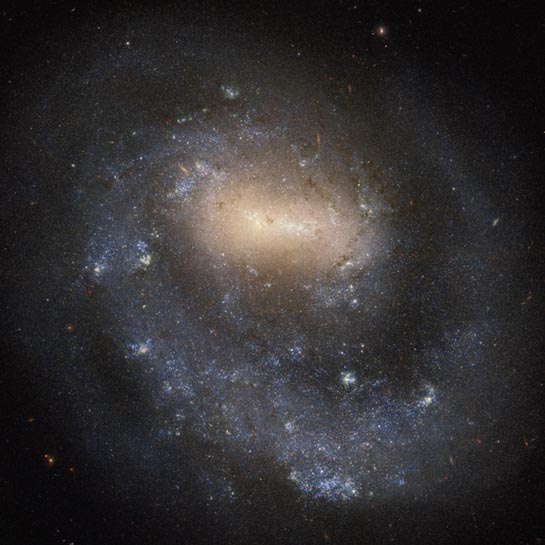
Spiral Galaxy
RA 12h 41m 32.86s Dec 41° 8' 46.72"
Canes Venatici
20 million light years
11.2
4.2 x 3.4 arcmin
3.18 x 3.34 arcminutes
North is 16.1° left of vertical
ESA/Hubble & NASA, I. Karachentsev
March 23, 2020
NGC 4625
ABOUT
THIS IMAGE:
NGC 4618 was discovered on April 9, 1787 by the German-British astronomer, Wilhelm Herschel, who also discovered Uranus in 1781. Only a year before discovering NGC 4618, Herschel theorized that the "foggy" objects astronomers were seeing in the night sky were likely to be large star clusters located much further away then the individual stars he could easily discern.
Since Herschel proposed his theory, astronomers have come to understand that what he was seeing was a galaxy. NGC 4618, classified as a barred spiral galaxy, has the special distinction amongst other spiral galaxies of only having one arm rotating around the center of the galaxy.
Located about 21 million light-years from our galaxy in the constellation Canes Venatici, NGC 4618 has a diameter of about one third that of the Milky Way. Together with its neighbor, NGC 4625, it forms an interacting galaxy pair, which means that the two galaxies are close enough to influence each other gravitationally. These interactions may result in the two (or more) galaxies merging together to form a new formation, such as a ring galaxy.
From Wikipedia:
NGC 4618 is a distorted barred dwarf galaxy in the constellation Canes Venatici. The galaxy is formally classified as a Sm galaxy, which means that its structure vaguely resembles the structure of spiral galaxies. The galaxy is sometimes referred to as a Magellanic spiral because of its resemblance to the Magellanic clouds.
Unlike most spiral galaxies, NGC 4618 has a single spiral arm, which gives the galaxy an asymmetric appearance. This galaxy was included in the Atlas of Peculiar Galaxies as one of three examples of nearby galaxies with single spiral arms. Although NGC 4618 is labeled as peculiar, many similar galaxies have been identified.
It
has been hypothesized that this galaxy's asymmetric structure may be the
result of a gravitational interaction with NGC 4625. Such asymmetric structure
is commonly seen among many interacting galaxies. However, observations
of neutral hydrogen gas in NGC 4618 and NGC 4625 imply that only some
of the gas outside the optical disks of NGC 4618 is affected by the gravitational
interaction. This may indicate that NGC 4618's one-arm shape forms as
the result of processes that are intrinsic to the galaxy itself.